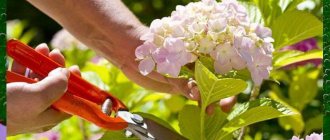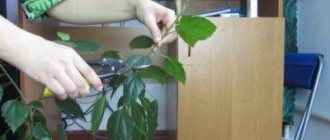When to prune forsythia
Forsythia is a fast-growing ornamental crop. It has the shape of a bush with multiple shoots. Therefore, pruning it is one of the important growing conditions.
Under natural conditions, forsythia grows up to two meters wide and three meters high. But as a landscape decoration, the growth of the bush is limited to 1.0-1.5 m.
Correction of the size and formation of the plant begins immediately after planting.
Forsythia after formation (photo)
Usually the plant is pruned after flowering. This pruning is used for a well-groomed bush.
Pruning before flowering is also possible. It is held in the first ten days of April or the last ten days of March. At this time, the leaves have not yet formed on the branches and the bush is clearly visible. Damaged branches and thickening shoots are clearly visible.
If the forsythia is in very poor condition, you can prune it during flowering.
But such pruning will not bring much benefit to the plant. During this period, it is most vulnerable to diseases and pests. And the cut points can cause the bush to become infected with diseases and harmful insects.
The main pruning of the bush is carried out in the fall, at the very beginning. But you shouldn’t cut out too many shoots. This can significantly reduce the plant's immunity in winter.
If it is not possible to regularly trim the forsythia bush, you can grow special dwarf varieties on your site.
Such bushes grow very slowly, and their height practically does not exceed one meter. Dwarf species require only maintenance and sanitary pruning.
These species do not require annual basic pruning. Shoots are shortened by a third once every three years. If desired, a bush can be formed in the shape of a ball.
Pruning forsythia can seem daunting. But it is quite possible to perform this procedure yourself. Don’t be afraid to spoil the bush, because new shoots grow very quickly.
Expert opinion
Yulia Yurievna
I have a large garden and vegetable garden, several greenhouses. I love modern methods of cultivating plants and mulching the soil, and I share my experience.
Ask a Question
When choosing the time to prune forsythia, it is important to remember that the plant requires a certain period of recovery. When pruning in autumn, the procedure should be carried out at least two weeks before a significant cold snap. When preparing for the procedure, it is important to disinfect and, if necessary, sharpen the pruning shears. For larger and not very young bushes, a lopper and a hacksaw may be required. If large branches are removed, it is better to treat the cut with garden varnish. To prevent the crop from becoming infected with fungal diseases or to prevent softened, rotten areas from appearing on the crown, branches should be removed only in dry weather. It is advisable to choose a time so that there is no precipitation in the next few days. Proper pruning should stimulate the appearance of growth and abundant flowering, and improve the health of the plant. In conditions of a thick crown, when not all branches receive enough sunlight and the air circulates poorly, diseases develop more often. During the pruning process, it is important to take into account that the described bush blooms only on last year’s branches. Their intensive removal will reduce the decorative effect of forsythia.
Pruning rules
Propagation of forsythia by cuttings - how to do it correctly
You can prune any shrub, including forsythia, with your own hands if you know the basic rules for this procedure and follow the instructions:
- Be sure to remove all diseased and weak branches. It is not difficult to identify such shoots; they will be dry, with cracked bark, thin, with bare areas.
- Branches that are very close to the soil are removed. This is done only if there is no need for vegetative propagation of the bush.
- It is necessary to trim branches that grow deep into the bush and thicken the crown.
- Young branches are shortened by half or a third; last year's shoots should not be touched.
- Cutting above the outer bud will stimulate the growth of branches outside the crown.
Once every 5 years, volumetric pruning of forsythia should be carried out to rejuvenate it. With this procedure, only old branches that are at soil level are removed. After this, the bush will not bloom in the spring, but it will become strong and healthy, which will ensure excellent flowering for several years to come.
How to prune a forsythia bush correctly
Pruning forsythia depends on the purpose of its cultivation. Bushes are usually planted as a separate decorative element in landscape design or as a bright hedge.
If the plant is formed as a single bush, the first pruning is carried out after planting it in open ground. All weak shoots are removed. In the first 2-3 years, pruning such a plant consists of removing frozen and damaged branches at the root.
Next, the main pruning is carried out in the summer. Faded branches are shortened by half. All damaged shoots are cut out at a level of 6-7 cm from the ground. This is necessary to thicken the plant. Subsequently, young shoots form on these stumps.
The main stages of pruning a plant:
- Removing ¼ of all old branches at the root
- Cutting out dead branches
- Trimming faded branches
- At the last stage, the bush is given symmetry or an original decorative shape.
Forsythia blooming (photo)
When planting a hedge, no pruning is carried out in the first 2-3 years. The plant must send out many long shoots, which subsequently intertwine with each other.
This creates a dense corset of flowering branches. Then sanitary pruning is carried out annually. It removes all damaged branches, as well as dead and dried shoots.
Forsythia is highly resistant to diseases and pests. But if, during flowering, twigs damaged by insects or any infection were found, it is recommended to cut them out and burn them.
Afterwards the bush is treated with special chemical or biological solutions.
During summer and autumn pruning, you can prepare material for propagating the bush. In June, green cuttings 15-20 cm long are cut and planted in a greenhouse.
In September, strong branches are selected and cuttings 10-15 cm long are prepared. They are planted directly into the ground, leaving 3 buds above its surface. For the winter, such seedlings must be covered.
Care after pruning
Transplanting hydrangea from one place to another - when and how to do it
After the main pruning, which is carried out in the fall, it is important to continue further care, because there is cold ahead that the plant will have to endure. Forsythia must be covered for the winter. Protective measures are extremely important even for those varieties that tolerate cold well. You can do without shelter only in the southern latitudes of Russia. The process of protecting a plant for the winter has the following step-by-step instructions:
- Forsythia is well watered, this is especially important if the plant was planted this season.
- A 10 cm layer of mulch is placed on the soil around the bush.
- The branches need to be pressed to the ground and pinned.
- After this, the bush is covered with a material that allows moisture and air to pass through, for example, spunbond is often used.
- The material needs to be strengthened along the edges; it is enough to lay more large stones, since the branches of the plant are quite elastic
Important! You cannot use polyethylene for covering; during the thaw period, the plant will be blocked under such material and may die.
Natural formation of a bush in landscape design
Before winter, you should not add mineral compounds, because the plant is preparing for dormancy. Fertilizers are used only in spring. If the soil is too poor, organic fertilizers can be added to enrich it. For mulch, you can use a ball of dry leaves covered with compost or humus.
To reduce the amount of pruning, forsythia can be planted in a larger area where the plant can reach maturity in natural growth. Formative and even sanitary pruning will not always help if the bush is sick. In this case, it is better to completely cut off the shoots, leaving about 10 cm of their length above the ground. Over the course of the season, this bush will be completely renewed.
If you know how and when to trim forsythia, you will be able to grow a healthy bush with lush flowering. The pruning procedure must be carried out regularly so as not to lose the decorative appearance of the plant.
Comments (4)
Peter
01/13/2018 at 12:01 |
The blooming forsythia in the pictures is so gorgeous! And my branches freeze slightly every winter, so it only grows in width. Trimming doesn't help with this. It's a shame. This year I will try to transplant it to another place and cover it for the winter.Answer
Yulia Expert Plodogorod
07/02/2019 at 19:58 |
Hello, Peter! To avoid such difficulties when growing the described shrub, you need not only to properly prepare it for wintering, but also to observe the peculiarities of care in the autumn.
To begin with, we recommend performing autumn pruning of the bush. First of all, dry branches are removed, those with cracked bark, thickening the crown and too long shoots.
Afterwards you need to remove shoots that are too close to the ground. You can leave such branches only if you plan to propagate by layering. You can also remove branches that are located very close to each other, as well as those that grow inside the crown. Additionally, you can remove anything that spoils the overall appearance of the bush crown.
It is better to carry out the described measures without waiting for a cold snap; you can prune the forsythia a few weeks after the end of flowering. We would like to note that this is not only a general sanitation of the bush. This procedure improves the winter hardiness of the bush.
As for shelter during the cold season, we recommend covering even frost-resistant varieties of this plant. 10-15 days after the end of flowering, it is better to water the forsythia abundantly and also feed it with potassium. These measures also contribute to better resistance to cold.
Before preparing for shelter, the soil around the bush is mulched with a thick layer. You can use peat or old sawdust. If the plant is not very large, the branches can be carefully bent to the ground and secured there with pins. Afterwards, the bush should be covered with agrofibre and secured around the perimeter either with pins or heavy stones.
If the plant is very large, then bending it to the ground runs the risk of damaging the shoots. Therefore, in this case it is better to make a frame around the plant and cover it with the same spunbond. You can use a chain-link mesh and wrap it around the plant. We do not recommend using polyethylene film for covering.
If you decide to feed the plant in the autumn, you need to choose products that do not contain nitrogen. You can also treat both the bush itself and the soil near it with drugs against diseases and pests. After all, it’s not uncommon for these uninvited guests to settle down for the winter simply in the crown or tree trunk circle.
Answer
Angelina
12/01/2019 at 01:14 |
I couldn't get my forsythia to bloom thickly in the spring. A friend advised me to completely renew the bush - cut all the stems as low as possible, almost to a stump! I did just that in August. New young growth has begun to sprout in spring! Now it's blooming well! And I start cutting it, forming a circle.
Answer
Yulia Expert Plodogorod
12/01/2019 at 21:42 |
Hello, Angelina! It is important to know what type of forsythia grows on your site. This will help determine what type of pruning is required because, for example, the rules for pruning dwarf and vigorous bushes of this crop are significantly different. In general, if the plant was old enough, such radical rejuvenation can help.
In addition to formation, we recommend not to forget about sanitation. It is important to remove weak, crown-thickening, dried, deformed and broken shoots. Also, in spring there may be frozen shoots. All these branches need to be removed to protect the bush from diseases and the development of pests.
Although forsythia tolerates pruning well, we recommend not removing more than 30% of the entire green mass at one time. This does not apply to cases when it is necessary to remove infected branches.
Also, before trimming such a bush, it is worth considering what shape it needs to be given. You can even use special templates to form bushes.
We would like to note that sometimes flowering is poor or absent due to a lack of nutrients in the soil. The first fertilizing is carried out in early spring. You can use rotted organic matter. Next, before flowering, we recommend applying mineral fertilizer with a predominance of phosphorus and potassium. After flowering, you can repeat the application of mineral products.
Additionally, we recommend that you always use only clean and sharp tools. This will help protect the tissue from infection in the wounds and additional injuries when trimming with blunt equipment.
Answer
8. Diseases and pests
Fungal diseases can cause late blight if the shrub grows in poorly drained soil with stagnant moisture. Bacterial wilt. Moniliosis. Leaf blades become light and even yellow if there is excess calcium in the soil. Plants rot when constantly flooded or planted in flooded lowlands.
Among insect pests, nematodes and aphids can attack plants.
↑ Up,











